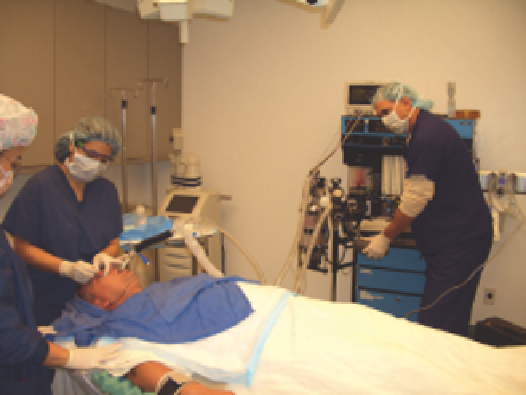Biomedical Engineering Reference
In-Depth Information
O
2
is not routinely required (although O
2
must always be avail-
able in case needed, and oximetry is critical). This lack of neces-
sity of oxygen is desirable in laser procedures where ignition is
always a risk and also allows for avoidance of masks, which
could restrict the field of the laser treatment for facial lesions.
The continuous infusion of ketamine helps limit the total dose
of the drug and allows flexible and delicate titration during the
procedure. The recommended dosage range is well documented
(56-62). Glycopyrrolate prevents the excessive secretions that
ketamine typically causes, and midazolam promotes tranquility
and amnesia.
Furthermore, the disadvantages of IV sedation should be con-
sidered. Although ketamine usually permits adequate or even
increased ventilation, hypoventilation can occur (50,54,63-66).
Coughing and laryngospasm, although rare, may also occur
(49,53,54). Excessive salivation with ketamine, although usually
blocked with a drying agent, may predispose to coughing and
laryngospasm (49). Emergence phenomena can be a problem
with ketamine, but midazolam seems to control this problem
adequately (45,46,50,66). Midazolam itself can cause hypov-
entilation, hiccups, excessive sedation, emesis, and emergence
delirium; careful dosing and vigilance are critical (49).
Figure 16.5
Typical laser operatory with monitoring, anesthesia, if desired and
emergency equipment readily available.
infusion is increased or supplemented with other IV agents
(usually, small doses of midazolam or fentanyl). Ondansetron
(Zofran) is a serotonin (5HT3) receptor antagonist that is fre-
quently used for the prevention and treatment of PONV. The
recommended dose is 4mg IV in adults and 0.1 mg/kg in chil-
dren, best given within 30 minutes of conclusion of the proce-
dure. It has minimal associated side effects and is generally
considered safe. Patients with a history of emesis during the
procedure can be given prophylactic droperidol (Inapsine),
0.625-1.25 mg IV. Some patients also receive IV diphenhydr-
amine at the beginning of the procedure to help limit ery-
thematous flaring around the lesion, which at times obscures
the margins for treatment.
At the conclusion of the procedure, the patient is closely
observed and monitored until consciousness resumes. In
particular, the patient is monitored for any problems with
emergence, such as vomiting, delirium, and coughing. Most
patients do very well with the above regimen; they maintain
stable vital signs, tolerate the procedure well, and awake
calmly. As with any technique, some problems are encoun-
tered, as follows:
Propofol Anesthesia
Propofol (Diprivan) is an IV sedative-hypnotic agent that can
be used for sedation, induction, and maintenance of general
anesthesia. It is slightly soluble in water and is formulated as
an emulsion containing the active agent 2,6 diisopropylphenol
(10 mg/mL) along with soybean oil, egg lecithin, and glycerol.
Propofol may be used as a single agent or in combination with
other sedatives, narcotics, or inhaled anesthetics. Induction of
anesthesia with propofol is smooth and rapid. Intermittent
bolus injections or a continuous infusion can be used to main-
tain anesthesia.
Propofol may offer advantages over the other sedative-
hypnotics because of its short duration of effect, rapid recov-
ery, and minimal side effects (67). Propofol is highly lipid
soluble, so after an induction dose, rapid blood-brain equili-
bration occurs, resulting in rapid loss of consciousness. After a
single bolus, blood concentrations fall rapidly because of
extensive tissue redistribution and rapid elimination. Meta-
bolic clearance is the highest of any IV hypnotic, even with
impairment of renal and hepatic function. Propofol blood
concentration and depth of sedation may be maintained by
intermittent bolus or continuous infusion.
Numerous dosage guidelines for propofol are provided in
the literature (68-72). A dosage range of 2-3 mg/kg for induc-
tion followed by an initial infusion of 25-300 mcg/kg/min is
common, depending on whether IV sedation or general anes-
thesia is being performed. If the infusion rate is titrated to
match the level of anesthesia to the level of surgical stimula-
tion, excessive drug level and prolonged recovery may be
avoided. Dosage requirements decrease with age and debility,
as well as with adjuvant opiates and premedication. Mainte-
nance of anesthesia should be administered by continuous
infusion rather than intermittent boluses, which may result in
undesirable oscillations of the propofol blood concentrations
and will vary the anesthetic depth. The infusion rate should
be titrated to the level of desired central nervous system
depression and to the duration of the procedure (68).
coughing during procedure
●
coughing on emergence
●
hiccups during procedure
●
emesis during procedure
●
emesis on emergence
●
excitement on emergence
●
irregular or decreased respiratory rate.
●
Each of these events occurs infrequently (less than 4% of pro-
cedures), and most of them are mild. Coughing responses are
the most worrisome reactions because of the concern for poten-
tial laryngospasm (53,54). Occasional respiratory rate irregular-
ity or slowing is extremely mild and responds well to adjustment
of ketamine infusion and avoidance of other IV agents. Emesis
is usually mild; vomitus is gently suctioned if necessary and dro-
peridol occasionally given. Hiccups rarely occur secondary to
midazolam or possibly ketamine use (49,53,55).
The use of ketamine in small boluses and infusion usually
permits adequate spontaneous ventilation so that supplemental
















